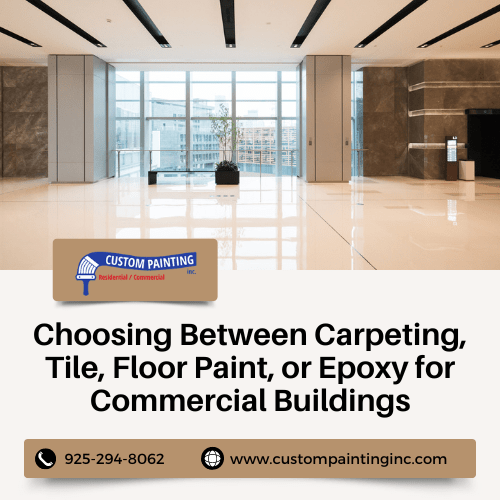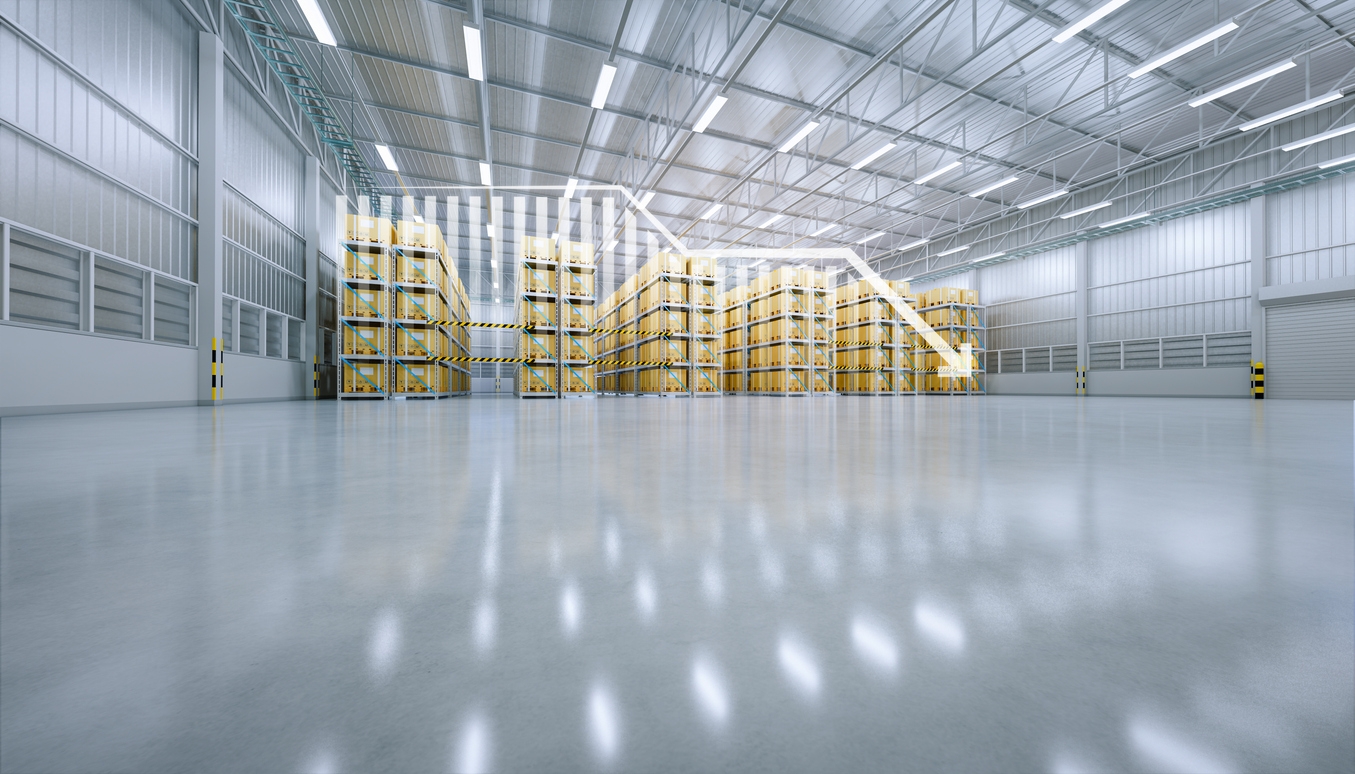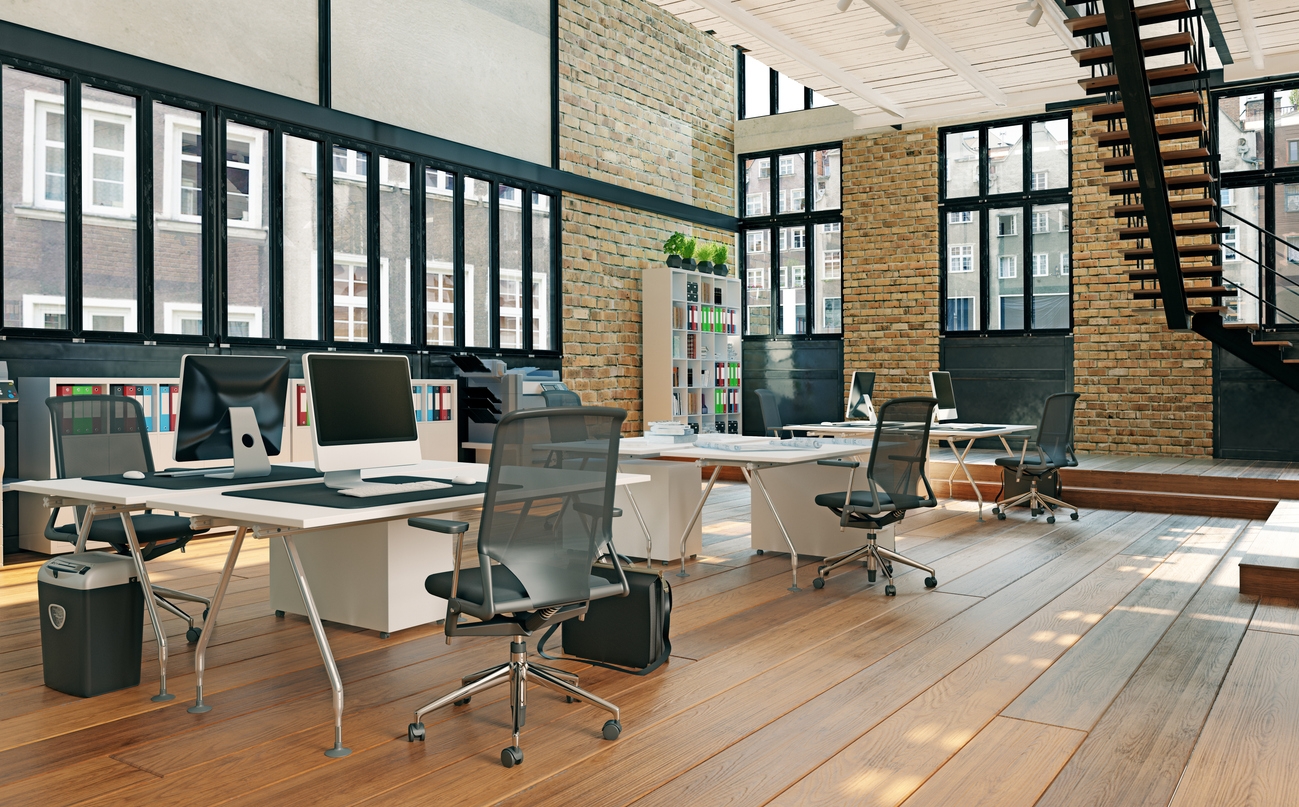When selecting the right flooring for Livermore area commercial buildings, business owners are often faced with several options, each with its own set of benefits and drawbacks. Carpeting, tile, floor paint, and custom epoxy are popular choices, but deciding which is best for your space can be challenging.
This article will explore the characteristics of each flooring type, helping you make an informed decision that suits your commercial needs. Whether you’re prioritizing aesthetics, durability, cost, or maintenance, understanding these options will guide you to the best choice for your building.
Carpeting
Carpeting offers several advantages for San Ramon area commercial spaces. It provides a comfortable and quiet environment by absorbing sound and reducing noise levels. This makes it an excellent choice for offices, hotels, and libraries where noise control is essential. Carpeting also adds an element of warmth and insulation, which can help with energy efficiency. Additionally, it offers a wide range of design options, colors, and patterns, allowing for customization to match the aesthetic of any commercial space.
Types of Commercial-Grade Carpet
- Broadloom Carpet: This type is woven on a wide loom and installed in large rolls. It is ideal for covering large areas seamlessly.
- Carpet Tiles: These are square pieces of carpet that can be installed individually. They are easy to replace if damaged and allow for creative designs and patterns.
- Cut Pile Carpet: Known for its luxurious feel, this type has fibers that are cut and twisted to create a soft surface.
- Loop Pile Carpet: This durable option features loops of yarn that stand upright. It is less prone to showing footprints and vacuum marks.
- Cut and Loop Carpet: This type combines cut and looped fibers to provide texture and patterns, adding a unique visual appeal.
Maintenance Requirements and Lifespan
Regular maintenance is crucial to extend the lifespan of commercial-grade carpets. Daily vacuuming helps remove dirt and debris, while periodic deep cleaning, such as steam cleaning, is necessary to maintain the carpet’s appearance and hygiene. Spills should be addressed promptly to prevent stains. The lifespan of commercial carpeting varies based on its quality and usage but generally ranges from 5 to 15 years. High-traffic areas may require more frequent replacement.
Best Uses
Carpeting is best suited for areas where noise reduction, comfort, and aesthetics are priorities. It is commonly used in office buildings, hotels, conference rooms, and educational institutions. It is also an excellent choice for spaces where employees or visitors spend a lot of time standing or walking, as it provides cushioning and reduces fatigue. However, carpeting may not be ideal for areas prone to moisture or heavy soiling, such as kitchens, bathrooms, or industrial spaces.
Tile
Tile flooring is a popular choice for Mountain House area commercial buildings due to its durability, ease of maintenance, and variety of design options. Tiles are resistant to stains, water, and wear, making them suitable for high-traffic areas. They offer a clean, professional appearance and can enhance the aesthetic appeal of any space. Additionally, tile flooring is hypoallergenic and does not trap dust or allergens, contributing to a healthier indoor environment.
Types of Tile
- Ceramic Tile: Made from clay and other natural materials, ceramic tiles are versatile and come in various colors, sizes, and finishes. They are suitable for most commercial applications.
- Porcelain Tile: Denser and more durable than ceramic, porcelain tiles are highly resistant to moisture and wear. They are ideal for areas with heavy foot traffic.
- Natural Stone Tile: Including options like marble, granite, and slate, natural stone tiles offer a luxurious look. Each piece is unique, adding a distinct character to the space.
- Vinyl Tile: Known for its affordability and ease of installation, vinyl tiles come in various designs, including those that mimic the appearance of wood or stone.
- Quarry Tile: Unglazed and durable, quarry tiles are suitable for commercial kitchens and industrial spaces due to their slip-resistant properties.
Installation Process and Cost Considerations
The installation of tile flooring involves several steps, starting with the preparation of the subfloor to ensure it is clean, level, and dry. The adhesive is then applied, and the tiles are laid in the desired pattern. Once the tiles are set, grout is applied to fill the gaps between them. Finally, the tiles and grout are sealed to protect against stains and moisture.
The cost of tile installation varies based on the type of tile, the size of the area, and the complexity of the installation. Ceramic and vinyl tiles are generally more affordable, while natural stone and porcelain tiles are on the higher end of the price spectrum. Labor costs can also add to the overall expense, especially for intricate patterns or custom designs.
Best Uses
Tile flooring is best suited for areas that require durability and easy maintenance. It is commonly used in lobbies, restrooms, kitchens, and hallways in commercial buildings. Porcelain and ceramic tiles are ideal for high-traffic areas due to their resilience. Natural stone tiles are often chosen for upscale spaces like hotel lobbies or executive offices for their aesthetic appeal.
Vinyl tiles are a budget-friendly option for retail stores, classrooms, and other commercial spaces where quick installation and affordability are priorities. Quarry tiles are perfect for commercial kitchens and industrial settings due to their slip resistance and durability.
Floor Paint
Floor paint is a cost-effective and versatile option for commercial flooring. It is easy to apply and can be customized with a wide range of colors to match the aesthetic of any space. Floor paint provides a smooth, clean finish that can enhance the appearance of a commercial area without the need for expensive flooring materials. Additionally, it can be applied quickly, reducing downtime for businesses.
Types of Floor Paint
- Latex Floor Paint: This water-based paint is easy to apply and dries quickly. It is suitable for areas with light foot traffic and offers a decent level of durability. Latex paint is also low in volatile organic compounds (VOCs), making it a more environmentally friendly option.
- Epoxy-Based Floor Paint: Known for its durability and resistance to chemicals and abrasions, epoxy floor paint is ideal for industrial and commercial settings. It forms a hard, protective coating that can withstand heavy use and is available in various colors and finishes.
- Urethane Floor Paint: Urethane paint provides a high-gloss, durable finish that is resistant to chemicals, UV light, and abrasions. It is often used in conjunction with epoxy paint for added protection and longevity. Urethane paint is ideal for areas that require a high level of durability and a glossy appearance.
Surface Preparation and Application Tips
Proper surface preparation is crucial for achieving the best results with floor paint. The surface must be clean, dry, and free of any dirt, grease, or old paint. This often involves sweeping, vacuuming, and washing the floor with a degreaser or cleaning solution. For concrete surfaces, etching with a mild acid solution may be necessary to create a rough texture that allows the paint to adhere better.
Once the surface is prepared, apply a primer if recommended by the paint manufacturer. Use a roller or brush to apply the floor paint evenly, working in small sections to avoid overlapping marks. For epoxy and urethane paints, mixing the components thoroughly is essential for proper curing and performance. As specified by the manufacturer, allow each coat to dry completely before applying additional coats. Proper ventilation is important during the application and drying process to ensure safety and effective curing.
Best Uses
Floor paint is best suited for areas that do not experience heavy foot traffic or significant wear and tear. It is commonly used in warehouses, storage areas, and light-traffic spaces where a cost-effective and easy-to-maintain flooring solution is needed. Latex floor paint is suitable for residential garages, basements, and utility rooms.
Epoxy-based and urethane paints are ideal for commercial and industrial settings, such as workshops, light manufacturing areas, and showrooms, where a durable and resistant surface is required. However, floor paint may not be the best choice for high-traffic areas, outdoor spaces, or environments with constant exposure to moisture.
Epoxy
Epoxy flooring is renowned for its high durability, chemical resistance, and versatile aesthetic options. It creates a tough, long-lasting surface that can withstand heavy traffic, making it ideal for commercial and industrial environments.
Epoxy floors are resistant to chemicals, oil, and other substances, ensuring they maintain their appearance and functionality even in harsh conditions. Additionally, epoxy coatings can be customized with a variety of colors, patterns, and finishes, including high-gloss and decorative options, allowing for a tailored look that enhances any space.
Types of Epoxy Coatings
- Self-Leveling Epoxy: This type of epoxy coating spreads out evenly over the floor, creating a smooth and seamless surface. It is ideal for areas where a high-gloss and flawless finish is desired. Self-leveling epoxy is commonly used in commercial, industrial, and residential settings.
- Mortar Epoxy: Mortar epoxy is the most robust and durable type, consisting of 100% solid epoxies combined with graded sand or quartz. It is used for repairing cracks before applying other epoxy coatings and is ideal for areas requiring high-impact resistance and strength, such as industrial spaces and warehouses.
- Anti-Slip Epoxy: This coating includes additives like quartz sand or aluminum oxide to create a textured surface that prevents slips and falls. It is essential for environments where safety is a concern, such as commercial kitchens, walkways, and ramps.
Installation Process and Professional vs. DIY Application
Installing epoxy flooring involves several key steps. First, the existing floor must be thoroughly cleaned and prepped, which may include grinding or shot blasting to remove any old coatings and ensure proper adhesion. Cracks and imperfections should be repaired, and a primer may be applied to enhance adhesion.
Once the floor is prepped, the epoxy mixture is prepared according to the manufacturer’s instructions. It is then poured onto the floor and spread evenly using rollers or squeegees. For self-leveling epoxy, the material will naturally flow to create a smooth surface. Multiple layers may be applied, with each coat needing to cure before the next is added. The entire process requires careful attention to detail and can take several days to complete, depending on the size and complexity of the area.
While DIY epoxy kits are available and can be a cost-effective option for smaller projects, professional installation is recommended for larger, more complex areas. Professionals have the experience, tools, and expertise to ensure a flawless finish and can handle the intricate details of mixing, application, and curing that can be challenging for DIYers.
Best Uses
Epoxy flooring is best suited for environments that require a durable and resilient surface. It is widely used in industrial spaces, such as factories and warehouses, where heavy machinery and equipment are common.
Epoxy is also a popular choice for garages, both residential and commercial, due to its resistance to oil and chemical spills. Additionally, it is ideal for heavy-traffic areas like retail stores, hospitals, and airports, where durability and ease of maintenance are crucial. The high aesthetic versatility of epoxy also makes it suitable for showrooms, commercial lobbies, and other spaces where a polished, professional appearance is desired.
Comparative Analysis
Selecting the right flooring for commercial buildings involves evaluating various options, each with its unique benefits, types, installation processes, and ideal uses. This comparative analysis explores carpeting, tile, floor paint, and epoxy to help you make an informed decision.
Benefits
Carpeting: Carpeting provides comfort, noise reduction, and insulation. It enhances the aesthetic appeal of spaces with a wide range of design options.
Tile: Tile flooring is durable, easy to maintain, and available in numerous designs. It is resistant to stains, water, and wear, making it ideal for high-traffic areas.
Floor Paint: Floor paint is a cost-effective and customizable option. It is easy to apply and offers a smooth finish that can enhance the appearance of commercial spaces.
Epoxy: Epoxy flooring is known for its high durability, chemical resistance, and versatile aesthetic options. It can withstand heavy traffic and harsh conditions, making it ideal for industrial environments.
Types
Carpeting:
- Broadloom Carpet: Ideal for large areas.
- Carpet Tiles: Easy to replace and customizable.
- Cut Pile Carpet: Soft and luxurious.
- Loop Pile Carpet: Durable and hides footprints.
- Cut and Loop Carpet: Provides texture and patterns.
Tile:
- Ceramic Tile: Versatile and affordable.
- Porcelain Tile: Durable and moisture-resistant.
- Natural Stone Tile: Luxurious and unique.
- Vinyl Tile: Affordable and easy to install.
- Quarry Tile: Slip-resistant and durable.
Floor Paint:
- Latex Floor Paint: Easy to apply and low in VOCs.
- Epoxy-Based Floor Paint: Durable and chemical-resistant.
- Urethane Floor Paint: High-gloss and resistant to UV light and abrasions.
Epoxy:
- Self-Leveling Epoxy: Creates a smooth, seamless surface.
- Mortar Epoxy: Extremely durable and used for repairing cracks.
- Anti-Slip Epoxy: Adds texture for slip resistance.
Installation Process and Cost Considerations
Carpeting: Installation involves laying the carpet over padding and securing it in place. Costs vary based on carpet type and area size. Regular maintenance is needed to extend its lifespan.
Tile: Tile installation requires preparing the subfloor, applying adhesive, laying tiles, grouting, and sealing. Costs depend on tile type and installation complexity. The tile is easy to clean and maintain.
Floor Paint: Surface preparation is crucial for floor paint, involving cleaning, repairing, and priming. Paint is applied in layers and allowed to cure. Costs are lower compared to other flooring options, but durability is also lower.
Epoxy: Epoxy installation involves surface preparation, mixing, and applying the epoxy. Multiple layers may be required, and curing time is essential. Professional installation is recommended for best results, which can be costly but offers high durability.
Best Uses
Carpeting: Ideal for offices, hotels, conference rooms, and educational institutions where noise reduction and comfort are priorities.
Tile: Suitable for lobbies, restrooms, kitchens, and high-traffic areas. Porcelain and ceramic tiles are ideal for commercial spaces, while quarry tiles are perfect for industrial kitchens.
Floor Paint: Best used in warehouses, storage areas, and light-traffic spaces. It is a budget-friendly option for areas where quick installation and customization are desired.
Epoxy: Epoxy is ideal for industrial spaces, garages, and heavy-traffic areas. It is also suitable for factories, warehouses, and commercial spaces requiring a durable and resistant surface.
Maintenance and Upkeep
Proper maintenance and upkeep are crucial for ensuring the longevity and appearance of flooring in commercial buildings. Each type of flooring—carpeting, tile, floor paint, and epoxy—requires specific maintenance practices to keep it in optimal condition.
Carpeting
Daily Maintenance:
- Vacuuming: Regular vacuuming is crucial to remove dirt, dust, and debris that can wear down carpet fibers. High-traffic areas may require daily vacuuming, while lower-traffic areas can be vacuumed less frequently.
- Spot Cleaning: Promptly address spills and stains using appropriate carpet cleaning solutions to prevent permanent damage.
Periodic Maintenance:
- Deep Cleaning: Schedule professional carpet cleaning, such as steam cleaning or hot water extraction, every 6 to 12 months to remove embedded dirt and allergens.
- Inspection: Regularly inspect the carpet for signs of wear, damage, or loose seams, and repair them promptly to prevent further deterioration.
Upkeep Tips:
- Use entrance mats to reduce the amount of dirt and moisture tracked onto the carpet.
- Implement a no-shoes policy or provide shoe covers in sensitive areas to minimize wear.
Tile
Daily Maintenance:
- Sweeping and Mopping: Sweep or vacuum the floor daily to remove loose dirt and debris. Mop with a mild cleaning solution to maintain cleanliness and shine.
Periodic Maintenance:
- Grout Cleaning: Clean grout lines periodically with a specialized grout cleaner to prevent discoloration and buildup.
- Sealing: Apply a sealer to natural stone tiles and grout lines every 1 to 2 years to protect against stains and moisture penetration.
Upkeep Tips:
- Place mats or rugs in high-traffic areas to reduce wear and prevent dirt from scratching the tile surface.
- Avoid using harsh chemicals or abrasive cleaners that can damage the tile finish.
Floor Paint
Daily Maintenance:
- Sweeping and Dusting: Regularly sweep or dust the painted floor to remove dirt and debris. Use a damp mop with a mild detergent for routine cleaning.
Periodic Maintenance:
- Inspection and Touch-Ups: Inspect the floor periodically for signs of wear, chips, or scratches. Touch up any damaged areas with matching paint to maintain an even appearance.
Upkeep Tips:
- Use protective pads under heavy furniture and equipment to prevent scratches.
- Avoid dragging heavy objects across the painted floor to prevent damage.
Epoxy
Daily Maintenance:
- Sweeping and Dust Mopping: Sweep or dust mop the floor daily to remove dirt and debris that can scratch the surface. Damp mop with a neutral cleaner as needed.
Periodic Maintenance:
- Deep Cleaning: Perform deep cleaning with an automatic scrubber and a non-abrasive, neutral cleaner every few months, depending on the level of traffic and usage.
- Inspection: Regularly inspect the epoxy floor for signs of damage or wear. Address any issues promptly to prevent further deterioration.
Upkeep Tips:
- Place mats at entryways to reduce the amount of dirt and moisture brought onto the floor.
- Use non-abrasive cleaning tools and avoid harsh chemicals that can damage the epoxy coating.
Final Thoughts
Choosing the right flooring for your commercial building involves considering factors like durability, maintenance, cost, and aesthetic appeal. Carpeting, tile, floor paint, and epoxy each offer unique benefits and are suited to different environments. For expert advice and professional installation, contact Custom Painting, Inc. at 925-294-8062 or via our contact form. We’re here to help you find the perfect flooring solution for your business.





